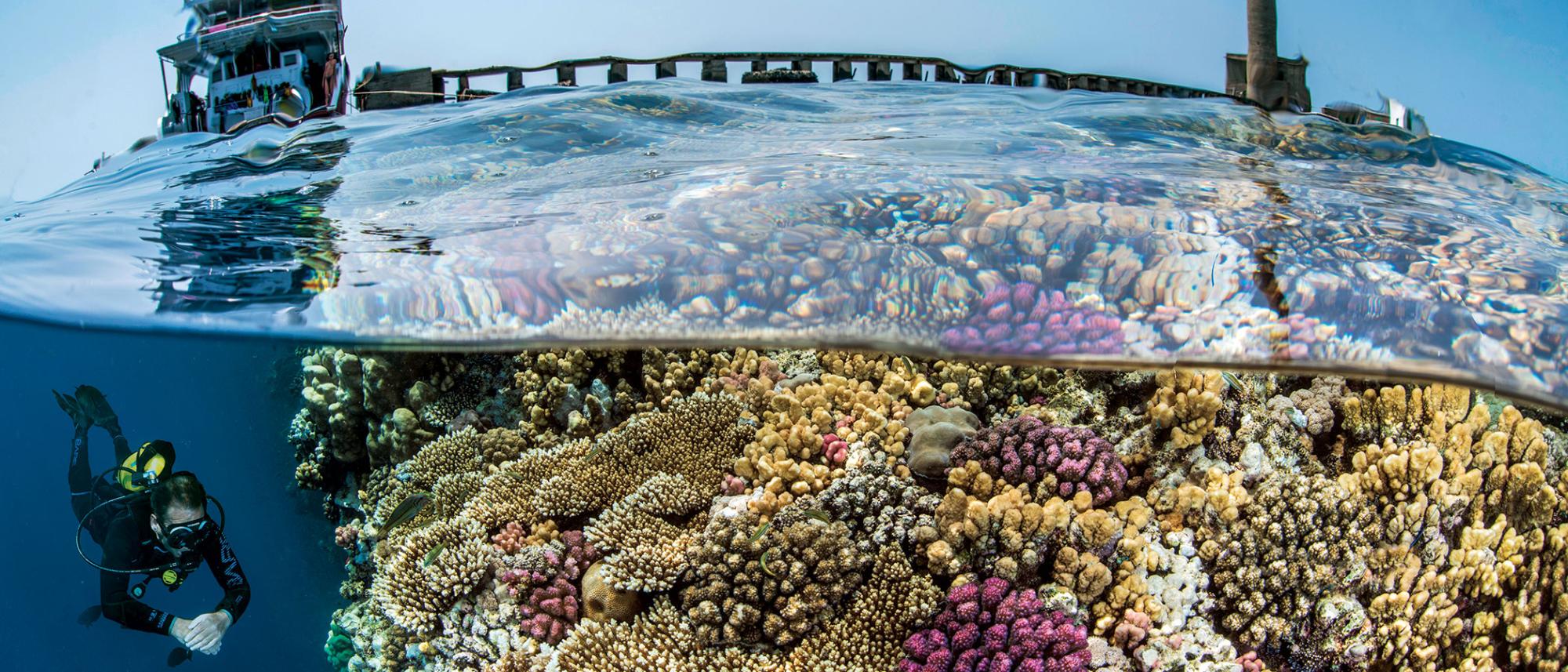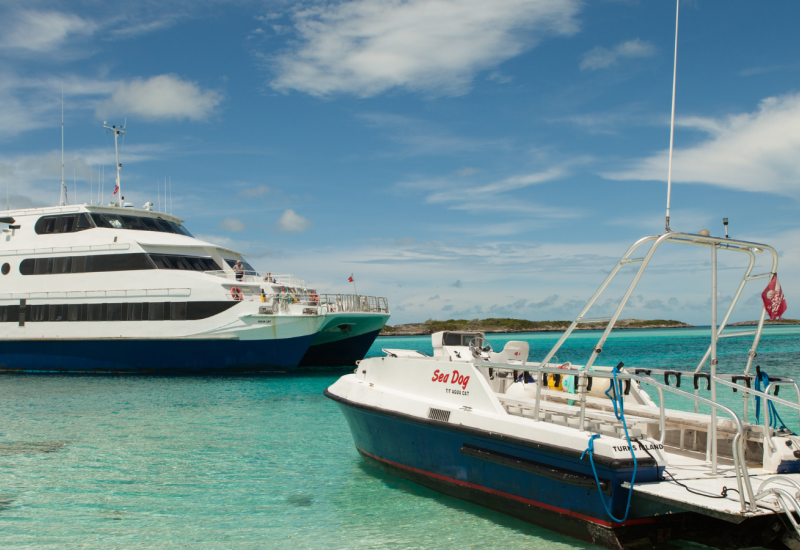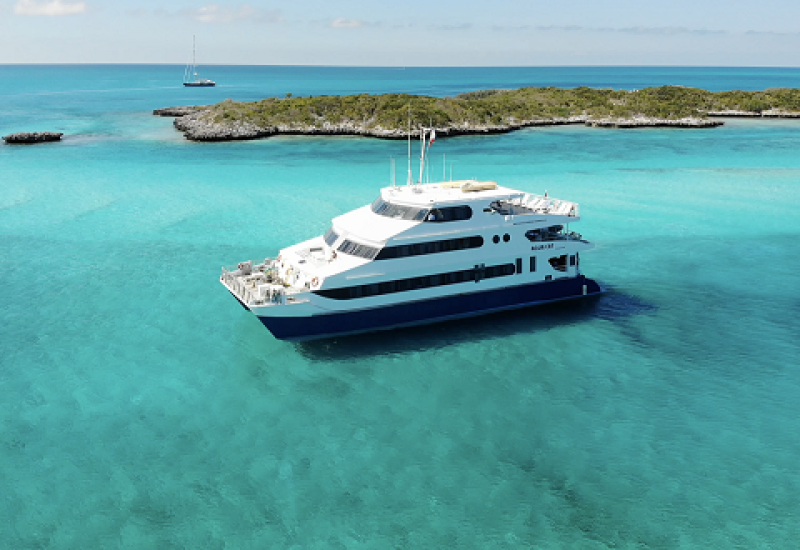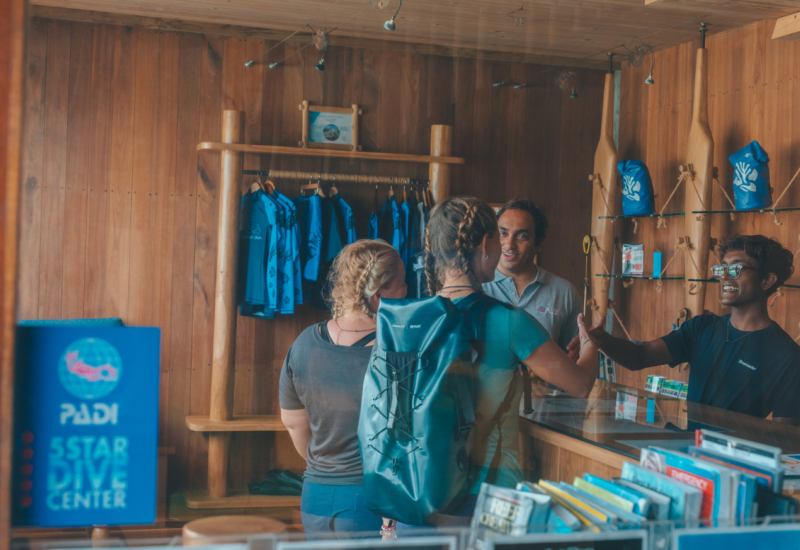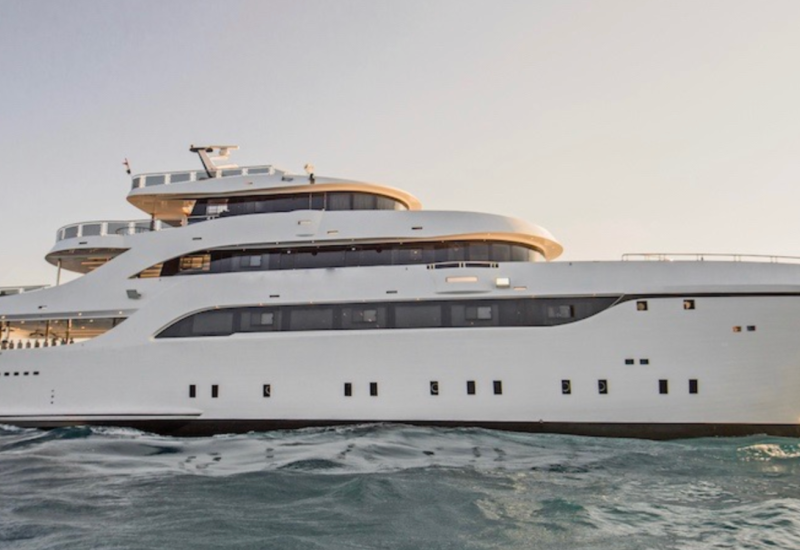The Red Sea's Deep South Delivers World-Class Scuba Diving off Sudan
You really can have too much of a good thing.
As an underwater photographer, I’ve learned this the hard way when a rich dive offers too many subjects. I fall victim once again in the southern Red Sea at Dahrat Abid with hammerhead sharks on the prowl.
We’re hanging at 115 feet near a wall that plunges another 400 feet to the bottom. I glance at my computer — 25 minutes of bottom time and 10 minutes no-deco time — when, in the distance, the silhouettes of large undulating bodies with wide, flat heads start to manifest.
It seems to be a tease — nothing shows up. Instead of waiting around, I opt to spend my remaining 10 minutes at nearby coral blocks filled with glassfish. As I set up on the wall and start shooting, sounds of clicking shutters and strobes being recycled are replaced by the sound of divers’ shakers going mad.
I turn back to the group of divers hanging in blue water and kick my fins as fast as I can. When I start recognizing the silhouettes in the distance, I know that I have just missed an intense moment. The immobile divers are intertwined with undulating shark bodies. There must be 50 or 60 of them. I arrive on the scene with five minutes to go, but the hammerheads do not stick around. Just as quickly as they came out of the dark, they disappear like ghosts again.
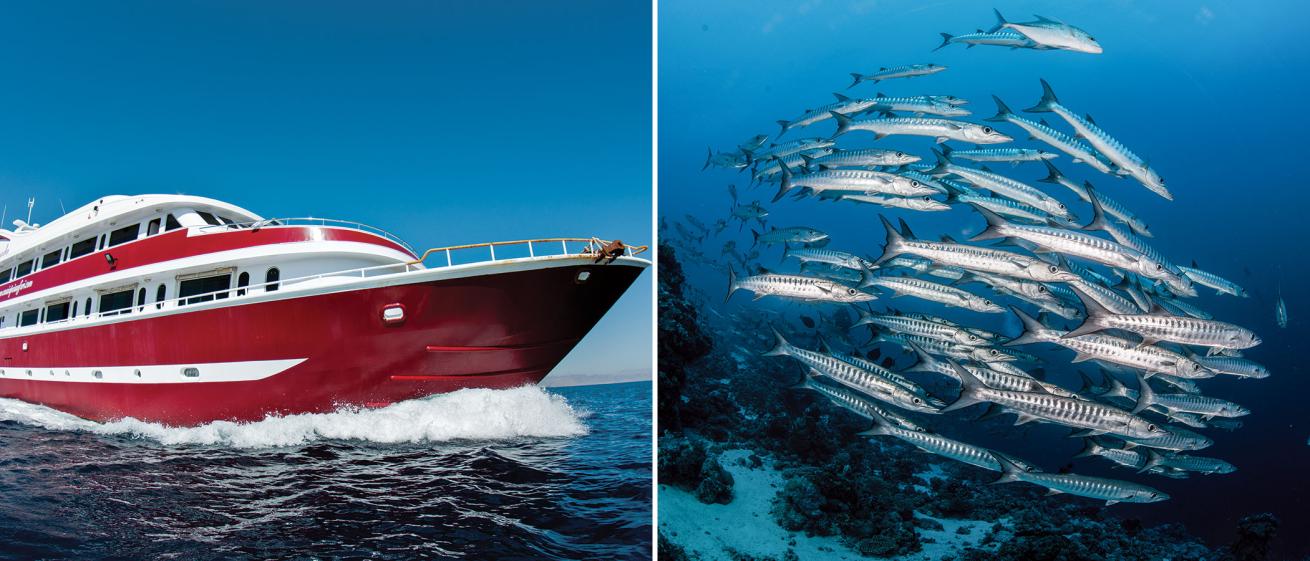
Martin StrmiskaM/Y Andromeda offers spacious lounges and the chance to see barracuda.
I try to catch my breath while I observe the faces of astonished divers and listen to the shouts of happiness. During our safety stop, I go through the images of that coral block and glassfish, and hope that my camera conjured one shot of hammerheads too. It didn’t. But something tells me it will capture plenty of amazing moments as the M/Y Andromeda liveaboard ushers us around the deep south of the Red Sea.
Tropical Touch
The ship’s flag barely moves. The mirrorlike surface of the water reflects nothing but light blue skies as the sun burns with an unseen force. The view out to the sea from the back deck of Andromeda resembles the scenery you would expect in Egypt — clear skies and water shimmering in all shades of blue.
Yet something is different.
I’ve often wondered what a typical Red Sea liveaboard excursion lacks in creating a classic tropical impression. It seems the answer is an island with palm trees and white sand. A place where you could step and let your toes sift through the finest white sand.
In Egypt, there’s always been just a yellow rocky coast in the distance; always the same sign of hot, arid desert. Now, as we head farther south than most Red Sea itineraries off the coast of Sudan, there are white sandy caps sticking out of the mirrorlike surface. We’re not quite in Egypt anymore. I could get used to this.
In Deep Love
As we make our way toward Sudan’s border with Eritrea over several days — stopping for dives along the way — the question hangs in the air: Will the diving this far south be worth the long journey? This morning the answer resounds clearly — yes!
The concentration of life around the Suakin Islands has no precedent in the Red Sea. Each of the seven islands offers unique sights underwater, even though they share a resemblance above the surface. They all amaze our group with rich plateaus and the deepest drop-offs you could imagine; we explore one covered in green and yellow corals, and then another drenched in purple and pink. At Gab Miyum, we’re surrounded by 20 curious silky sharks, and at Dahrat Abid, 100 hammerheads swim by.
The unique diversity on display allows everyone to find a different subject of interest. While one diver is enamored with a school of giant sweetlips, another admires the tornado of barracuda a few away.
All seven islands are just a few miles away from each other. Schools of fish that swallow divers and darken their view, the unexpected encounters with large pelagic animals, and the concentration of life per square foot fascinate our group of international divers. The coral reef of Dahrat Abid reminds me more of Indonesia than the Red Sea. Concentration of marine life as intense as Egypt offered decades ago is down here still to experience, pristine reefs living intact for centuries. The dense coral reefs here are still inhabited by giant jacks and chevron barracuda, and the deep is still patrolled by big tuna and gray reef sharks.
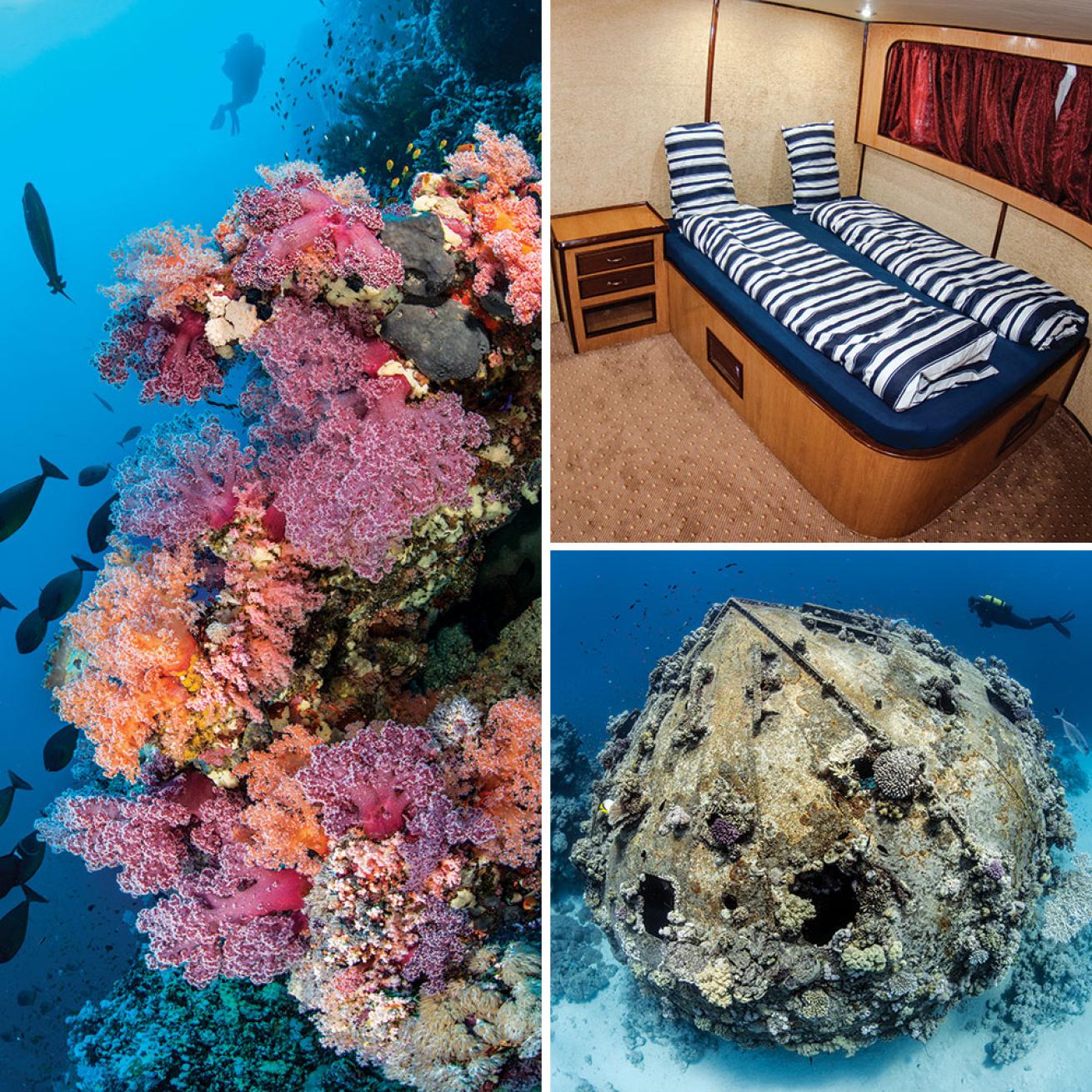
Martin Strmiska(Clockwise from top) The Suakin Islands’ colorful walls; Andromeda’s honeymoon suite; Precontinent II
Everyone’s heartbeat kicks up another notch at Ambar Reef. If seeing the large school of hammerheads at about 130 feet wasn’t enough, we come across a massive population of bumphead parrotfish that have made their home here. They like hanging out in rough shallows at the top of the reef, where careless divers and too-keen photographers could risk an injury. Approaching them in the worst weather, just like today’s, is not an easy task, but the payoff is up-close photo ops with the goofy-looking fish.
The most memorable experience here is the raid of unicornfish. A bevy of thousands of unicorns surrounds my buddy so he disappears from view.
Remnants of the Past
Pioneer Jacques Cousteau was so amazed by the variety of life at Shaab Rumi that in 1963, he constructed a habitat here. Precontinent II — one in a series of underwater “villages” created by Cousteau — let him and a few other marine biologists live at a depth of 30 feet for up to four weeks. The best-preserved structure here is a garage for the submarine, a metal mushroom that sits with three legs at the sandy bottom in 35 feet of water. Its large welded cap — stretching 12 feet across — is covered in hard and soft corals. White whip corals hanging down from its structure illustrate how long this has been here, just like the old mushroom tells the story of Cousteau. Aside from looking into the past, the dive has very little to offer. For the real thrills, Andromeda’s rubber RIBs bring us outside the atoll to the southern plateau.
This site reminds me of a miniature of Shaab Rumi. A large school of chevron barracuda and big-eye jacks frequent the area, but the most interesting inhabitants are potato grouper. There are around 30 individuals hanging around and playing a game of hide-and-seek — another challenge for keen photographers.
The Sanganeb Lighthouse, built on the southern side of the coral ring, can be seen from miles away. For us, it is a clear sign that the two-week cruise is ending. The top of the lighthouse offers a never-ending view of the northern turquoise shallows. The coral ring has two plateaus to dive — one in the north and another in the south. On our dive, I take advantage of the tall lighthouse as one of the few landmarks in the Red Sea that a photographer can include in split-level frames.
We make our final dive at the wreck of the Umbria. In the deep south, Andromeda was the only boat at a majority of the sites. We were spoiled. Having the company of two other boats here takes away the feeling of solitude.
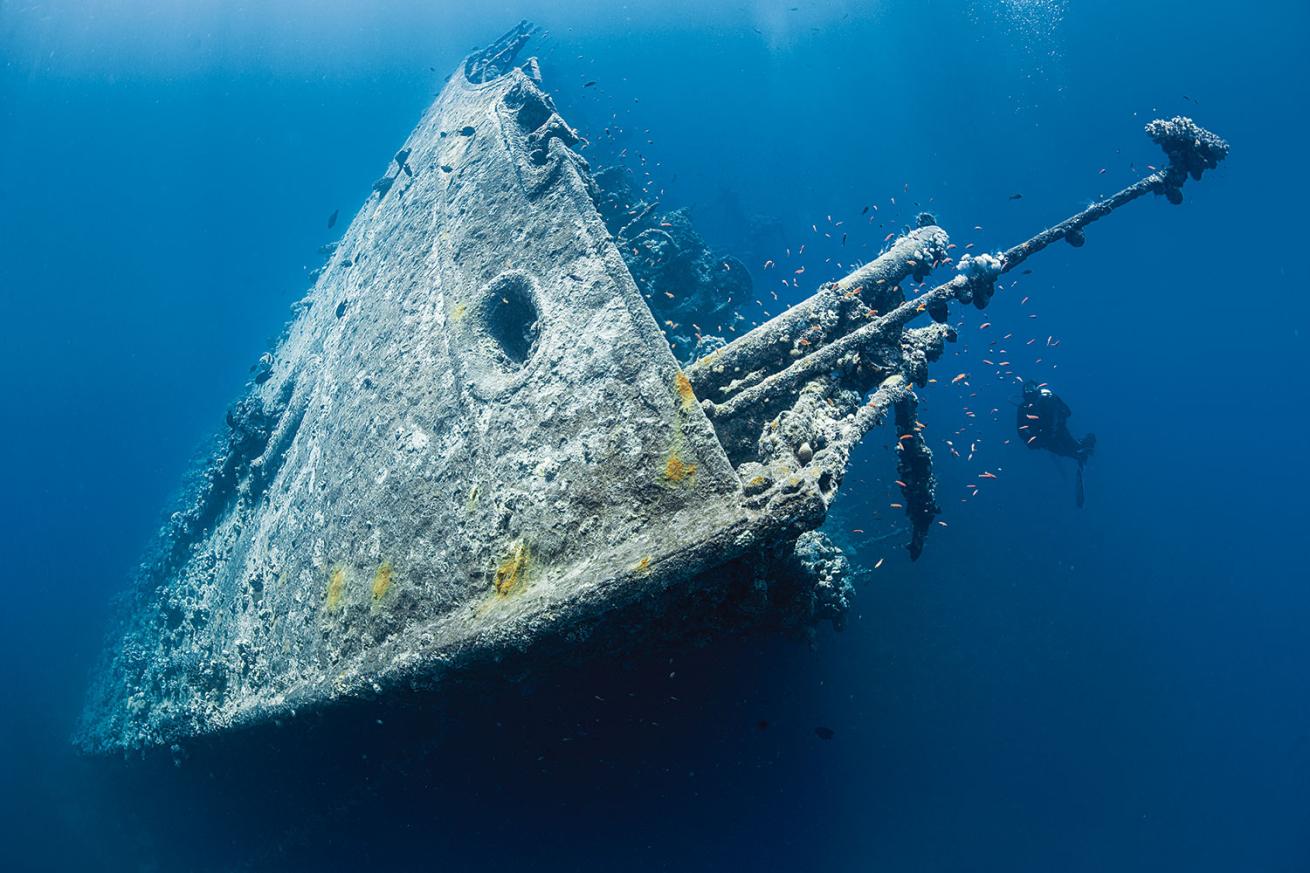
Martin StrmiskaThe bow of the Umbria.
Diving Umbria — a 500-foot ocean liner scuttled with thousands of bombs aboard during World War II — feels similar to the popular Thistlegorm farther north in the Red Sea. It is about the same size and has similar character and charm. Hard corals growing on the railings remind me of small colorful nests. Many are homes for small coral creatures such as banded dascyllus and red-spotted coral crabs.
Large parrotfish feed on the coral during the day. At night, they find a place to sleep and create a slimy wrap around themselves, but small cleaner shrimp often find a way past this defense and into the bubble. Both walkways around the captain’s bridge pull divers into a magical mood and are popular spots for wide-angle photography, but the real jewel Umbria has to offer lies inside its trunk — Fiat 1100 Lunga cars. They are lined up nicely in complete darkness. Similar to motorbikes in the Thistlegorm, they are the most popular subject for photographers.
Scrolling through my photos at the end of the two-week excursions — eyeing everything from an underwater habitat to relics of war — I see this Red Sea excursion was well worth the journey after all.
Need to Know
When to Go: Winter (December through March) is generally better for hammerhead sightings as the water gets colder (71-77 degrees F). The summer mating season starts earlier than it does farther north. From April through July, huge schools of mating fish are frequently seen. Masses of oriental sweetlips are typically seen on every corner of a reef, with a chance to see hammerheads available in deeper water.
Operator: Andromeda is a 130-foot yacht with a 26-foot beam and 13 double cabins that each have a private bathroom. The liveaboard has a large sun deck, a dive deck with two handheld showers, and two Zodiacs. One- and two-week itineraries to the northern and southern Red Sea are offered.
Traveling Tips: The U.S. Department of State labeled Sudan with a Level 3: Reconsider Travel advisory at time of press. Visit travel.state.gov to see details on the advisory and particular areas of conflict to inform your plans. Avoid bringing alcohol into the country; it is often confiscated. You can buy alcohol aboard Andromeda. Emirates offers flights into Dubai from most major airports. Connecting flights are offered from Dubai to Port Sudan.
Price Tag: A two-week liveaboard trip starts around $3,100 before fees. Nitrox is available at an additional charge.

